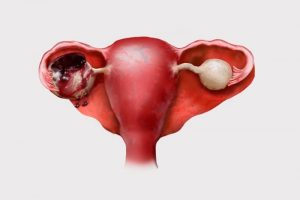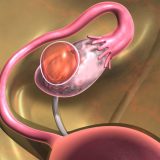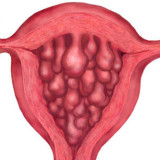Endometrioid ovarian cyst is also known as the “chocolate cyst”. Endometrial cyst is a cavity filled with brown or black secretions inside on the sides of the endometrium. Women may not be aware of this until the doctor finds a cyst during the examination or an ultrasound scan.
Endometrial cyst can cause chronic pelvic pain, increase the risk of ovarian cancer, or hinder pregnancy. If cysts are ignored, they can grow to the size of an orange and burst. This usually occurs during or after menstruation. After a cyst ruptures, its contents fall into the abdominal cavity. A woman begins to feel a sharp pain in her stomach. In this situation, the risk of infection, bleeding, pain during urination and bowel movements increase.
Endometrioid ovarian cyst – the most common symptoms
In the early stages of endometrial cyst disease, symptoms are often absent. Over time, symptoms typical of endometriosis may occur, such as: pain in the lower abdomen, which persists and may worsen before and during menstruation. There may also be very heavy and prolonged menstrual bleeding, painful sexual intercourse or pain during urination and bowel movements.
Endometrial ovarian cyst is the most common type of endometrial cyst.
The most common type of endometriosis is an estrogen-dependent endometrial cyst or a chocolate cyst. It occurs in about 17-50% of women with endometriosis. The size of the cyst varies from 5 cm (size of a tennis ball) to 20 cm (size of a grapefruit). Cysts can be located one after another or several on each ovary. Although endometriosis usually occurs in women and girls of childbearing age, there are also cases where cysts appear in women during menopause or before menopause. As with all types of diseases, the etiology of ovarian endometriosis remains unknown. Its cause is multistep, including many factors, such as genetic predisposition, stem cell disorders, immune disorders (autoimmune) and environmental factors.
The most serious consequences of not treating or poorly treating ovarian endometriosis can be:
- irreversible ovarian dysfunction, chronic pelvic pain;
- infertility and other potential complications that require urgent medical attention.
In addition, it is also a major cause of hysterectomy and costly hospitalizations. Thus, an endometrial ovarian cyst has become one of the most serious public health problems of our time.
Herbal medicine
The herbs used to stimulate the endocrine system, maintain hormonal balance, or regulate ovulation can prevent the onset of ovarian cysts. It is necessary to distinguish:
- Maca Peruvian. It improves the reproductive and sexual system of women. The plant also regulates the metabolic processes of the body and strengthens the circulatory system;
- Milk thistle. This plant stimulates protein synthesis and starts the regeneration process in the body;
- Sacred Vitex. It has several beneficial properties: sedative, antimicrobial, disinfecting and antifungal;
- Yarrow. It has several useful properties: antiallergic properties, pain killer. Reducing intestinal swelling and the fight against flatulence.
Treatment of endometrioid ovarian cyst
In determining the method of treatment, the doctor takes into account the patient’s age, the level of pain experienced and whether she plans to have a child in the future. Based on this, a plan is selected, which may include:
- Medical surveillance. If there is no severe pain and the cyst is small, the doctor may suggest monitoring and wait 6-8 weeks to check if the cyst has been destroyed. Ultrasound is then used to make sure that the cyst is no longer present or that it continues to grow;
- Pharmacotherapy – your doctor may recommend antagonists. They can cause side effects similar to menopause symptoms, such as hot flashes, loss of bone density, and decreased sex drive; should not take them when trying to get pregnant;
- Surgical procedures – the surgeon can use several methods of treating a cyst, including: aspiration and removal of the cyst wall – freeing the fluid from the cyst and then using various forms of energy, such as electric current or laser, to destroy the cyst wall, excision – this treatment option consists in the complete removal of a cyst from the ovary, oophorectomy.
Endometrial ovarian cyst is a very dangerous disease. It can cause serious damage to the entire female body. When diagnosing such a cyst, try to follow all the recommendations of the doctor. Try not to self-medicate. Your health depends only on your attention to your body. Take care of yourself!













